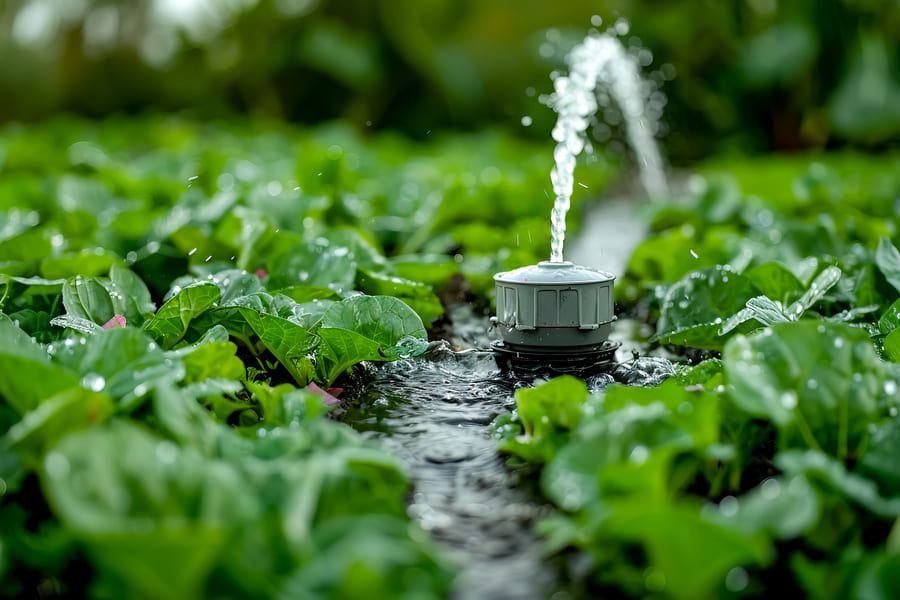Posted On: April 22, 2025
Posted By: KSNM DRIP

Farming in hilly regions comes with unique challenges, especially when it comes to water management. Uneven terrain, rapid runoff, and inconsistent moisture levels can make traditional irrigation methods inefficient and wasteful. That’s where drip irrigation steps in as a game-changer. By delivering water directly to plant roots in a slow and controlled manner, it prevents soil erosion, minimizes wastage, and ensures optimal hydration even on sloped landscapes. But does it work as effectively in hilly areas as it does on flat land? Let’s explore how drip irrigation can revolutionize water management in hilly agricultural regions.
Yes, a drip irrigation system can work effectively in hilly regions, but it requires proper design adjustments to manage water pressure and distribution. Compared to other irrigation methods commonly used in hilly areas, such as furrow irrigation, sprinkler irrigation, and terraced irrigation, drip irrigation offers several advantages in terms of water efficiency, soil conservation, and crop health.
Drip Irrigation conserves water, prevents soil erosion, and ensures that plants receive adequate moisture, even in uneven terrain. However, proper system design, including pressure regulators, contour-based layouts, and gravity-assisted water flow, is essential for maximum effectiveness. If the goal is precision farming with minimal water wastage, drip irrigation outperforms other methods in hilly regions.
Water naturally flows downhill, causing excessive moisture at lower elevations and insufficient supply at higher points.
Steep slopes lead to rapid water runoff, washing away fertile topsoil and reducing water absorption by crops.
Sloped terrain prevents effective water infiltration, leading to poor moisture retention in the soil.
Installing irrigation systems requires extra investment in pressure regulation and contour-based layouts to ensure even water distribution.
Many hilly regions rely heavily on unpredictable rainfall due to a lack of consistent water sources.
Collecting and transporting water from rivers, lakes, or reservoirs to higher elevations is challenging and often requires pumps or storage systems.
Poor water management, excessive irrigation, or heavy rainfall can weaken slopes, increasing the risk of landslides that damage crops and infrastructure.
Hilly areas experience unpredictable weather patterns, including dry spells and heavy rains, making efficient water management difficult.
Drip irrigation plays a crucial role in managing water efficiently in hilly agricultural regions by addressing the challenges posed by uneven terrain, soil erosion, and water scarcity. Here’s how it helps:
Minimizes Water Loss: Delivers water directly to plant roots, reducing evaporation and runoff, which is common in sloped areas.
Ensures Uniform Distribution: Pressure-compensating drippers regulate water flow, ensuring even moisture supply across different elevations.
Prevents Soil Erosion: Slow and controlled water release prevents excessive runoff, protecting the topsoil from being washed away.
Improves Water Efficiency: Uses up to 50% less water than traditional irrigation methods, making it ideal for regions with limited water availability.
Adapts to Sloped Terrain: Can be installed along contour lines, allowing gravity to assist in distributing water efficiently.
Reduces Dependency on Rainfall: Helps maintain consistent soil moisture even in dry spells, leading to better crop yield and sustainability.
Supports Water Storage Solutions: Works well with rainwater harvesting systems, ensuring an efficient water supply during dry periods.
Enhances Crop Health: Provides precise hydration, reducing water stress and improving plant growth, even on uneven landscapes.
With proper planning and installation, drip irrigation becomes a reliable and sustainable water management solution for hilly regions, optimizing both resources and productivity.
Installing a drip irrigation system in hilly regions requires careful planning to ensure efficient water distribution and prevent erosion. By following a step-by-step approach, you can optimize water usage, maintain soil health, and improve crop yield. Here’s a simple process to set up a reliable drip irrigation system on sloped terrain.
Assess the land’s slope, soil type, and water source, then design the layout to ensure even water distribution.
Install a filtration system to prevent clogging and set up a pump if needed to maintain adequate pressure.
Lay the mainline and sub-mainline pipes along contour lines to minimize erosion, using durable materials like PVC or HDPE.
Install control valves at different levels to regulate water flow and use pressure regulators to balance uneven distribution.
Place lateral drip lines along plant rows and use pressure-compensating emitters for uniform irrigation.
Run water through the system to check for leaks or blockages and adjust emitters and regulators for even coverage.
Regularly clean filters, inspect pipes for damage, and monitor for blockages caused by debris or algae buildup.
To know the complete drip irrigation setup for any terrain, you can check out 10 Easy Steps to Installing a Drip Irrigation System.
Install drip lines along contour lines to prevent water from flowing downhill too quickly and ensure even distribution.
Use pressure-compensating drippers and pressure regulators to maintain uniform water flow across different elevations.
Position water tanks at the highest point to utilize gravity for efficient water distribution and reduce reliance on pumps.
Apply mulching or grow cover crops to retain moisture and minimize soil erosion caused by runoff.
Divide the area into irrigation zones based on slope and crop water requirements to balance water supply effectively.
Install proper filtration systems to prevent emitter clogging, especially when using water from natural sources.
Adjust irrigation schedules according to seasonal changes, rainfall, and temperature variations to avoid overwatering or underwatering.
Select crops with suitable root depth for hilly terrain and ensure proper spacing to optimize water absorption.
Drip irrigation is more than just a water-saving technique, it’s a sustainable solution for farming in hilly regions. By adapting to the natural slopes, preventing soil erosion, and ensuring uniform water distribution, it helps farmers maximize yield with minimal resources. While proper system design is crucial, the long-term benefits in terms of efficiency, crop health, and environmental conservation make it a worthwhile investment. With the right setup, drip irrigation transforms the challenges of hilly farming into opportunities for sustainable growth.